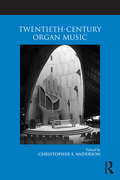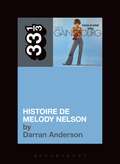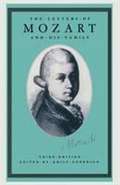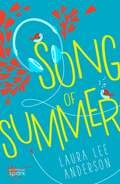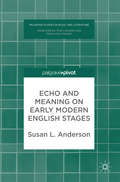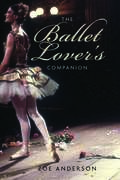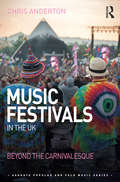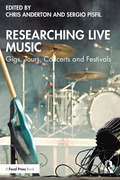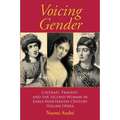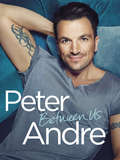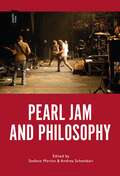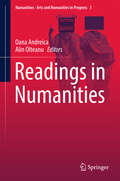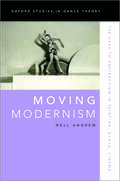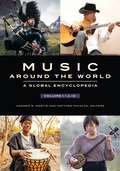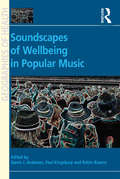- Table View
- List View
Twentieth-Century Organ Music
by Christopher S. AndersonThis volume explores twentieth-century organ music through in-depth studies of the principal centers of composition, the most significant composers and their works, and the evolving role of the instrument and its music. The twentieth-century was a time of unprecedented change for organ music, not only in its composition and performance but also in the standards of instrument design and building. Organ music was anything but immune to the complex musical, intellectual, and socio-political climate of the time. Twentieth-Century Organ Music examines the organ's repertory from the entire period, contextualizing it against the background of important social and cultural trends. In a collection of twelve essays, experienced scholars survey the dominant geographic centers of organ music (France, the Netherlands, Scandinavia, the United States, and German-speaking countries) and investigate the composers who made important contributions to the repertory (Reger in Germany, Messiaen in France, Ligeti in Eastern and Central Europe, Howells in Great Britain). Twentieth-Century Organ Music provides a fresh vantage point from which to view one of the twentieth century's most diverse and engaging musical spheres.
Twentieth-Century Organ Music
by Christopher S. AndersonThis volume explores twentieth-century organ music through in-depth studies of the principal centers of composition, the most significant composers and their works, and the evolving role of the instrument and its music. The twentieth-century was a time of unprecedented change for organ music, not only in its composition and performance but also in the standards of instrument design and building. Organ music was anything but immune to the complex musical, intellectual, and socio-political climate of the time. Twentieth-Century Organ Music examines the organ's repertory from the entire period, contextualizing it against the background of important social and cultural trends. In a collection of twelve essays, experienced scholars survey the dominant geographic centers of organ music (France, the Netherlands, Scandinavia, the United States, and German-speaking countries) and investigate the composers who made important contributions to the repertory (Reger in Germany, Messiaen in France, Ligeti in Eastern and Central Europe, Howells in Great Britain). Twentieth-Century Organ Music provides a fresh vantage point from which to view one of the twentieth century's most diverse and engaging musical spheres.
Serge Gainsbourg's Histoire de Melody Nelson (33 1/3)
by Darran AndersonOutside his native France, the view of Serge Gainsbourg was once of a one-hit wonder lothario. This has been slowly replaced by an awareness of how talented and innovative a songwriter he was. Gainsbourg was an eclectic, protean figure; a Dadaist, poète maudit, Pop-Artist, libertine and anti-hero. An icon and iconoclast. His masterpiece is arguably Histoire de Melody Nelson, an album suite combining many of his signature themes; sex, taboo, provocation, humour, exoticism and ultimately tragedy. Composed and arranged with the great Jean-Claude Vannier, its score of lush cinematic strings and proto-hip hop beats, combined with Serge's spoken-word poetry, has become remarkably influential across a vast musical spectrum; inspiring soundtracks, indie groups and electronic artists. In recent years, the album's reputation has grown from cult status to that of a modern classic with the likes of Beck, Portishead, Mike Patton, Air and Pulp paying tribute. How did the son of Jewish Russian immigrants, hounded during the Nazi Occupation, rise to such notoriety and acclaim, being celebrated by President François Mitterand as "our Baudelaire, our Apollinaire"? How did the early chanson singer evolve into a musical visionary incorporating samples, breakbeats and dub into his music, decades ahead of the curve? And what are the roots and legacy of a concept album about a Rolls Royce, a red-haired Lolita muse, otherworldly mansions, plane crashes and Cargo Cults?
Serge Gainsbourg's Histoire de Melody Nelson (33 1/3)
by Darran AndersonOutside his native France, the view of Serge Gainsbourg was once of a one-hit wonder lothario. This has been slowly replaced by an awareness of how talented and innovative a songwriter he was. Gainsbourg was an eclectic, protean figure; a Dadaist, poète maudit, Pop-Artist, libertine and anti-hero. An icon and iconoclast. His masterpiece is arguably Histoire de Melody Nelson, an album suite combining many of his signature themes; sex, taboo, provocation, humour, exoticism and ultimately tragedy. Composed and arranged with the great Jean-Claude Vannier, its score of lush cinematic strings and proto-hip hop beats, combined with Serge's spoken-word poetry, has become remarkably influential across a vast musical spectrum; inspiring soundtracks, indie groups and electronic artists. In recent years, the album's reputation has grown from cult status to that of a modern classic with the likes of Beck, Portishead, Mike Patton, Air and Pulp paying tribute. How did the son of Jewish Russian immigrants, hounded during the Nazi Occupation, rise to such notoriety and acclaim, being celebrated by President François Mitterand as "our Baudelaire, our Apollinaire"? How did the early chanson singer evolve into a musical visionary incorporating samples, breakbeats and dub into his music, decades ahead of the curve? And what are the roots and legacy of a concept album about a Rolls Royce, a red-haired Lolita muse, otherworldly mansions, plane crashes and Cargo Cults?
Letters Of Mozart And His Family (PDF)
by Emily Anderson Wolfgang Amadeus Mozart Stanley Sadie Fiona SmartThis study has been revised to include new finds about the composition dates of several Mozart works. A new bibliography and a collation with the Neue Mozart-Ausgabe edition of letters, edited by O.E.Deutsch, W.A.Bauer and J.H.Eibl: Baerenreiter, 1962-75 is also included.
Song of Summer
by Laura Lee AndersonThe thirteen qualities of Robin's Perfect Man range from the mildly important "Handsome†? to the all-important "Great taste in music.†? After all, Westfield's best high school folk musician can't go out with some schmuck who only listens to top 40 crap. So when hot Carter Paulson walks in the door of Robin's diner, it looks like the list may have come to life after all...until she realizes he's profoundly deaf. Carter isn't looking for a girlfriend. Especially not a hearing one. Not that he has anything against hearing girls, they just don't speak the same language. But when the cute waitress at Grape Country Dairy makes an effort to talk with him, he takes her out on his yellow Ducati motorcycle.Music, language, and culture all take a backseat as love drives the bike. But how long can this summer really last?
Music and Performance in the Book of Hours (Routledge Research in Music)
by Michael Alan AndersonThis study uncovers the musical foundations and performance suggestions of books of hours, guides to prayer that were the most popular and widespread books of the late Middle Ages. Exploring a variety of musical genres and sections of books of hours with musical implications, this book presents a richly textured sound world gleaned from dozens of extant manuscript sources from fifteenth-century France. It offers the first overview of the musical content of these handbooks to liturgy and devotional prayer, together with cues that show scribal awareness for the articulation of sacred plainchants. Although books of hours lack musical notation, this survey elucidates the full range of musical genres and styles suggested both within and beyond the liturgical offices prescribed in books of hours. Privileging sound and ritual enactment in the experience of the hours, the survey complements studies of visual imagery that have dominated the category. The book’s interdisciplinary approach within a musical context, and beautiful full-color illustrations, will attract not only specialists in musicology, liturgy, and late medieval studies, but also those more broadly interested in the history of the book, memory, performance studies, and art history.
Music and Performance in the Book of Hours (Routledge Research in Music)
by Michael Alan AndersonThis study uncovers the musical foundations and performance suggestions of books of hours, guides to prayer that were the most popular and widespread books of the late Middle Ages. Exploring a variety of musical genres and sections of books of hours with musical implications, this book presents a richly textured sound world gleaned from dozens of extant manuscript sources from fifteenth-century France. It offers the first overview of the musical content of these handbooks to liturgy and devotional prayer, together with cues that show scribal awareness for the articulation of sacred plainchants. Although books of hours lack musical notation, this survey elucidates the full range of musical genres and styles suggested both within and beyond the liturgical offices prescribed in books of hours. Privileging sound and ritual enactment in the experience of the hours, the survey complements studies of visual imagery that have dominated the category. The book’s interdisciplinary approach within a musical context, and beautiful full-color illustrations, will attract not only specialists in musicology, liturgy, and late medieval studies, but also those more broadly interested in the history of the book, memory, performance studies, and art history.
Echo and Meaning on Early Modern English Stages
by Susan L. AndersonThis book examines the trope of echo in early modern literature and drama, exploring the musical, sonic, and verbal effects generated by forms of repetition on stage and in print. Focusing on examples where Echo herself appears as a character, this study shows how echoic techniques permeated literary, dramatic, and musical performance in the period, and puts forward echo as a model for engaging with sounds and texts from the past. Starting with sixteenth century translations of myths of Echo from Ovid and Longus, the book moves through the uses of echo in Elizabethan progress entertainments, commercial and court drama, Jacobean court masques, and prose romance. It places the work of well-known dramatists, such as Ben Jonson and John Webster, in the context of broader cultures of performance. The book will be of interest to scholars and students of early modern drama, music, and dance.
Echo and Meaning on Early Modern English Stages
by Susan L. AndersonThis book examines the trope of echo in early modern literature and drama, exploring the musical, sonic, and verbal effects generated by forms of repetition on stage and in print. Focusing on examples where Echo herself appears as a character, this study shows how echoic techniques permeated literary, dramatic, and musical performance in the period, and puts forward echo as a model for engaging with sounds and texts from the past. Starting with sixteenth century translations of myths of Echo from Ovid and Longus, the book moves through the uses of echo in Elizabethan progress entertainments, commercial and court drama, Jacobean court masques, and prose romance. It places the work of well-known dramatists, such as Ben Jonson and John Webster, in the context of broader cultures of performance. The book will be of interest to scholars and students of early modern drama, music, and dance.
Popular Music in a Digital Music Economy: Problems and Practices for an Emerging Service Industry (Routledge Research in Music)
by Tim J. AndersonIn the late 1990s, the MP3 became the de facto standard for digital audio files and the networked computer began to claim a significant place in the lives of more and more listeners. The dovetailing of these two circumstances is the basis of a new mode of musical production and distribution where new practices emerge. This book is not a definitive statement about what the new music industry is. Rather, it is devoted to what this new industry is becoming by examining these practices as experiments, dedicated to negotiating what is replacing an "object based" industry oriented around the production and exchange of physical recordings. In this new economy, constant attention is paid to the production and licensing of intellectual property and the rise of the "social musician" who has been encouraged to become more entrepreneurial. Finally, every element of the industry now must consider a new type of audience, the "end user", and their productive and distributive capacities around which services and musicians must orient their practices and investments.
Popular Music in a Digital Music Economy: Problems and Practices for an Emerging Service Industry (Routledge Research in Music)
by Tim J. AndersonIn the late 1990s, the MP3 became the de facto standard for digital audio files and the networked computer began to claim a significant place in the lives of more and more listeners. The dovetailing of these two circumstances is the basis of a new mode of musical production and distribution where new practices emerge. This book is not a definitive statement about what the new music industry is. Rather, it is devoted to what this new industry is becoming by examining these practices as experiments, dedicated to negotiating what is replacing an "object based" industry oriented around the production and exchange of physical recordings. In this new economy, constant attention is paid to the production and licensing of intellectual property and the rise of the "social musician" who has been encouraged to become more entrepreneurial. Finally, every element of the industry now must consider a new type of audience, the "end user", and their productive and distributive capacities around which services and musicians must orient their practices and investments.
The Ballet Lover's Companion
by Zoe AndersonThis engaging book is a welcome guide to the most successful and loved ballets seen on the stage today. Dance writer and critic Zoe Anderson focuses on 140 ballets, a core international repertory that encompasses works from the ethereal world of romantic ballet to the edgy, muscular works of modern choreographers. She provides a wealth of facts and insights, including information familiar only to dance world insiders, and considers such recent works as Alexei Ramansky's Shostakovich Trilogy and Christopher Wheeldon's The Winter's Tale as well as older ballets once forgotten but now returned to the repertory, such as Sylvia. To enhance enjoyment of each ballet, Anderson also offers tips on what to look for during a performance. Each chapter introduces a period of ballet history and provides an overview of innovations and advancement in the art form. In the individual entries that follow, Anderson includes essential facts about each ballet’s themes, plot, composers, choreographers, dance style, and music. The author also addresses the circumstances of each ballet’s creation and its effect in the theater, and she recounts anecdotes that illuminate performance history and reception. Reliable, accessible, and fully up to date, this book will delight anyone who attends the ballet, participates in ballet, or simply loves ballet and wants to know much more about it.
Music Festivals in the UK: Beyond the Carnivalesque (Ashgate Popular and Folk Music Series)
by Chris AndertonThe outdoor music festival market has developed and commercialised significantly since the mid-1990s, and is now a mainstream part of the British summertime leisure experience. The overall number of outdoor music festivals staged in the UK doubled between 2005 and 2011 to reach a peak of over 500 events. UK Music (2016) estimates that the sector attracts over 3.7 million attendances each year, and that music tourism as a whole sustains nearly 40,000 full-time jobs. Music Festivals in the UK is the first extended investigation into this commercialised rock and pop festival sector, and examines events of all sizes: from mega-events such as Glastonbury Festival, V Festival and the Reading and Leeds Festivals to ‘boutique’ events with maximum attendances as small as 250. In the past, research into festivals has typically focused either on their carnivalesque heritage or on developing managerial tools for the field of Events Management. Anderton moves beyond such perspectives to propose new ways of understanding and theorising the cultural, social and geographic importance of outdoor music festivals. He argues that changes in the sector since the mid-1990s, such as professionalisation, corporatisation, mediatisation, regulatory control, and sponsorship/branding, should not necessarily be regarded as a process of transgressive 'alternative culture’ being co-opted by commercial concerns; instead, such changes represent a reconfiguration of the sector in line with changes in society, and a broadening of the forms and meanings that may be associated with outdoor music events.
Music Festivals in the UK: Beyond the Carnivalesque (Ashgate Popular and Folk Music Series)
by Chris AndertonThe outdoor music festival market has developed and commercialised significantly since the mid-1990s, and is now a mainstream part of the British summertime leisure experience. The overall number of outdoor music festivals staged in the UK doubled between 2005 and 2011 to reach a peak of over 500 events. UK Music (2016) estimates that the sector attracts over 3.7 million attendances each year, and that music tourism as a whole sustains nearly 40,000 full-time jobs. Music Festivals in the UK is the first extended investigation into this commercialised rock and pop festival sector, and examines events of all sizes: from mega-events such as Glastonbury Festival, V Festival and the Reading and Leeds Festivals to ‘boutique’ events with maximum attendances as small as 250. In the past, research into festivals has typically focused either on their carnivalesque heritage or on developing managerial tools for the field of Events Management. Anderton moves beyond such perspectives to propose new ways of understanding and theorising the cultural, social and geographic importance of outdoor music festivals. He argues that changes in the sector since the mid-1990s, such as professionalisation, corporatisation, mediatisation, regulatory control, and sponsorship/branding, should not necessarily be regarded as a process of transgressive 'alternative culture’ being co-opted by commercial concerns; instead, such changes represent a reconfiguration of the sector in line with changes in society, and a broadening of the forms and meanings that may be associated with outdoor music events.
Researching Live Music: Gigs, Tours, Concerts and Festivals
by Chris AndertonResearching Live Music offers an important contribution to the emergent field of live music studies. Featuring paradigmatic case studies, this book is split into four parts, first addressing perspectives associated with production, then promotion and consumption, and finally policy. The contributors to the book draw on a range of methodological and theoretical positions to provide a critical resource that casts new light on live music processes and shows how live music events have become central to raising and discussing broader social and cultural issues. Their case studies expand our knowledge of how live music events work and extend beyond the familiar contexts of the United States and United Kingdom to include examples drawn from Argentina, Australia, France, Jamaica, Japan, New Zealand, Switzerland, and Poland. Researching Live Music is the first comprehensive review of the different ways in which live music can be studied as an interdisciplinary field, including innovative approaches to the study of historic and contemporary live music events. It represents a crucial reading for professionals, students, and researchers working in all aspects of live music.
Researching Live Music: Gigs, Tours, Concerts and Festivals
by Chris Anderton Sergio PisfilResearching Live Music offers an important contribution to the emergent field of live music studies. Featuring paradigmatic case studies, this book is split into four parts, first addressing perspectives associated with production, then promotion and consumption, and finally policy. The contributors to the book draw on a range of methodological and theoretical positions to provide a critical resource that casts new light on live music processes and shows how live music events have become central to raising and discussing broader social and cultural issues. Their case studies expand our knowledge of how live music events work and extend beyond the familiar contexts of the United States and United Kingdom to include examples drawn from Argentina, Australia, France, Jamaica, Japan, New Zealand, Switzerland, and Poland. Researching Live Music is the first comprehensive review of the different ways in which live music can be studied as an interdisciplinary field, including innovative approaches to the study of historic and contemporary live music events. It represents a crucial reading for professionals, students, and researchers working in all aspects of live music.
Voicing Gender: Castrati, Travesti, and the Second Woman in Early-Nineteenth-Century Italian Opera (PDF)
by Naomi AndréThe early 19th century was a period of acute transition in operatic tradition and style, when time-honoured practices gave way to the developing aesthetics of Romanticism, the rise of the tenor overtook the falling stars of the castrati, and the heroic, the masculine, and the feminine were profoundly reconfigured. These transformations resounded in operatic plot structures as well; the happy resolution of the 18th century twisted into a tragic 19th-century finale with the death of the helpless and innocent heroine - and frequently her tenor hero along with her. Female voices which formerly had sung en travesti, or basically in male drag, opposite their female character counterparts then took on roles of the second woman, a companion and foil to the death-bound heroine rather than her romantic partner. In "Voicing Gender", Naomi Andre skillfully traces the development of female characters in these first decades of the century, weaving in and around these changes in voicings and plot lines, to define an emergent legacy in operatic roles.
Peter Andre - Between Us
by Peter AndreWith his easy charm, down-to-earth personality and natural good looks, it's no wonder that Peter Andre has legions of fans across the globe. Whilst once best known for producing chart-topping pop songs, selling millions of records worldwide and performing sell-out venues all over the world, in recent years he has shown himself to be a man of diverse talents. From presenting television shows to mastering ballroom dancing on Strictly Come Dancing; from launching a successful coffee shop business to the work he does for charities close to his heart.In this warm and intimate book, Peter invites you to take a look behind the scenes of his incredible life. He'll talk about the highs and lows he has experienced: how he met and fell in love with his wife, Emily; his joy at the arrival of his daughter Amelia; the laughs and fun he has with his two older children, Junior and Princess and how his music has evolved to reflect a new period in his life. He'll also touch on the worst time of his life, when he lost his brother, Andrew, to cancer, the unbreakable bond he has with his family and what the future holds for him.Packed with gorgeous colour photographs - many of them never seen before - this is a unique and very personal insight into the world of one of our best-loved celebrities.
Pearl Jam and Philosophy
by Andrea Schembari Stefano MarinoThe first scholarly discussion on the band, Pearl Jam and Philosophy examines both the songs (music and lyrics) and the activities (live performances, political commitments) of one of the most celebrated and charismatic rock bands of the last 30 years. The book investigates the philosophical aspects of their music at various levels: existential, spiritual, ethical, political, metaphysical and aesthetic. This philosophical interpretation is also dependent on the application of textual and poetic analysis: the interdisciplinary volume puts philosophical aspects of the band's lyrics in close dialogue with 19th- and 20th-century European and American poetry. Through this widespread philosophical examination, the book further looks into the band's immense popularity and commercial success, their deeply loyal fanbase and genuine sense of community surrounding their music, and the pivotal place the band holds within popular music and contemporary culture.
Readings in Numanities (Numanities - Arts and Humanities in Progress #3)
by Oana Andreica Alin OlteanuThis unique book gathers articles from the numanistic perspective of multidisciplinarity and innovation, connected by three main theoretical interests or overarching themes: music, semiotics and translation. Offering an eclectic collection of innovative papers that address such topics as culture, musicology, art consumption, meaning, codes and national identities, to name a few, it has a broad appeal across the humanities and social sciences. The contributing authors draw on various schools and methodologies, including psychology, psychoanalysis, social semiotics, semiotic modelling, deconstruction and cultural analysis. By approaching established themes in new and challenging ways, this highly engaging book has the potential to advance the state of the art in various topics. It appeals to all scholars investigating cultural identity, linguistics and translation, music consumption, performance, semiotic theories and various intersections of these and related topics.
Moving Modernism: The Urge to Abstraction in Painting, Dance, Cinema (Oxford Studies in Dance Theory)
by Nell AndrewThe emergence of modern dance and the early history of cinema ran concurrent with the European avant-garde's development of pictorial abstraction in the first decades of the 20th century. However, many assume that modernist abstraction resulted from a century of natural, autonomous evolution to painting styles and tastes. In Moving Modernism, author Nell Andrew challenges this assumption. By examining dance and film created during this period, she argues that performative modes of art created the link between bodily movement and movement depicted in modernist paintings. In a seeming paradox, dance and film - durational arts, involving real bodies in space-participated in the development of abstract art. With archival material collected in North America and Europe, Moving Modernism resurfaces lost performances, identifies working methods, and establishes the circles of aesthetic influence and reception for avant-garde dance pioneers and experimental film makers from the turn of the century to the interwar period. Reexamining the motivation that fueled the emergence of abstraction, Andrew claims that painters sought meaning not only in the material and formal picture but also in temporal and sensorial experience. Andrew looks at major figures and intellectual movements including Loïe Fuller and Symbolism; Valentine de Saint-Point and the Cubo-Futurist and neo-Symbolist movements; and early cinematic abstraction from Edison and the Lumières to Hans Richter and Marcel Duchamp. Close examinations of each figure show that theatrical display, embodied self-projection, and kinesthetic desire are not necessarily in opposition to pictorial abstraction; in fact, they expand our understanding of the urges that created modern art.
Moving Modernism: The Urge to Abstraction in Painting, Dance, Cinema (Oxford Studies in Dance Theory)
by Nell AndrewThe emergence of modern dance and the early history of cinema ran concurrent with the European avant-garde's development of pictorial abstraction in the first decades of the 20th century. However, many assume that modernist abstraction resulted from a century of natural, autonomous evolution to painting styles and tastes. In Moving Modernism, author Nell Andrew challenges this assumption. By examining dance and film created during this period, she argues that performative modes of art created the link between bodily movement and movement depicted in modernist paintings. In a seeming paradox, dance and film - durational arts, involving real bodies in space-participated in the development of abstract art. With archival material collected in North America and Europe, Moving Modernism resurfaces lost performances, identifies working methods, and establishes the circles of aesthetic influence and reception for avant-garde dance pioneers and experimental film makers from the turn of the century to the interwar period. Reexamining the motivation that fueled the emergence of abstraction, Andrew claims that painters sought meaning not only in the material and formal picture but also in temporal and sensorial experience. Andrew looks at major figures and intellectual movements including Loïe Fuller and Symbolism; Valentine de Saint-Point and the Cubo-Futurist and neo-Symbolist movements; and early cinematic abstraction from Edison and the Lumières to Hans Richter and Marcel Duchamp. Close examinations of each figure show that theatrical display, embodied self-projection, and kinesthetic desire are not necessarily in opposition to pictorial abstraction; in fact, they expand our understanding of the urges that created modern art.
Music around the World [3 volumes]: A Global Encyclopedia [3 volumes]
by Andrew R. Martin and Matthew Mihalka, EditorsWith entries on topics ranging from non-Western instruments to distinctive rhythms of music from various countries, this one-stop resource on global music also promotes appreciation of other countries and cultural groups.A perfect resource for students and music enthusiasts alike, this expansive three-volume set provides readers with multidisciplinary perspectives on the music of countries and ethnic groups from around the globe. Students will find Music around the World: A Global Encyclopedia accessible and useful in their research, not only for music history and music appreciation classes but also for geography, social studies, language studies, and anthropology. Additionally, general readers will find the books appealing and an invaluable general reference on world music.The volumes cover all world regions, including the Americas, Europe, Africa and the Middle East, and Asia and the Pacific, promoting a geographic understanding and appreciation of global music. Entries are arranged alphabetically. A preface explains the scope of the set as well as how to use the encyclopedia, followed by a brief history of traditional music and important current influences of music in each particular world region.
Soundscapes of Wellbeing in Popular Music (Geographies of Health Series)
by Gavin J. Andrews Paul Kingsbury Robin KearnsUnearthing the messy and sprawling interrelationships of place, wellbeing, and popular music, this book explores musical soundscapes of health, ranging from activism to international charity, to therapeutic treatments and how wellbeing is sought and attained in contexts of music. Drawing on critical social theories of the production, circulation, and consumption of popular music, the book gathers together diverse insights from geographers and musicologists. Popular music has become increasingly embedded in complex and often contradictory discourses of wellbeing. For instance, some new genres and sub-cultures of popular music are associated with violence, drug-use, and the angst of living, yet simultaneously define the hopes and dreams of millions of young people. At a service level, popular music is increasingly used as a therapeutic modality in holistic medicine, as well as in conventional health care and public health practice. The genre of popular music, then, is fundamental to human wellbeing as an active and central part of people’s emotional lives. By conceptually and empirically foregrounding place, this book demonstrates how - music whether from particular places, about particular places, or played in particular places ” is a crucial component of health and wellbeing.
